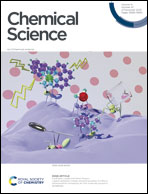A series of caged fluorophores for calibrating light intensity†
Abstract
Absolute measurement of light intensity is sought for in multiple areas of chemistry, biology, physics, and engineering. It can be achieved by using an actinometer from analyzing the time-course of its reaction extent on applying constant light. However, most reported actinometers exploit the absorbance observable for reporting the reaction extent, which is not very sensitive nor relevant in imaging systems. In this work, we report a series of hydrophobic and hydrophilic caged fluorophores that overcome the preceding limitations. Based on the robust pyranine backbone, they can easily be synthesized on a large scale in one to a few steps. Their brightness increases over illumination and their uncaging cross-sections have been thoroughly characterized upon one- and two-photon excitation. As a demonstration of their use, we calibrated light intensity in various chemical and biological samples, which have been observed with epifluorescence and confocal imaging systems.



 Please wait while we load your content...
Please wait while we load your content...